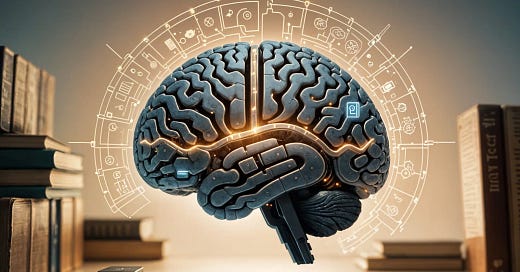AI and the History of Cognitive Decline
AI is just the latest in a line of technological trends, following smartphones and social media, that could potentially impair our cognitive abilities over time if used indiscriminately.
I remember taking the subway to work about 20 years ago. I had my (heavy) laptop in a bag hanging on my shoulder. In a pocket next to my laptop I always carried a book. The trip was roughly one hour long and so I had about two hours a day of reading time. I used to read a book every couple of weeks or so. And I wasn't the only one. Everybody read in the subway. People with books in their hands was an ordinary sight back then.
Fast forward to 2025, this picture changed dramatically. The books have been replaced by smartphones. Not only that but content consumption has changed from what was once long format text to very short videos. People just scrolling endlessly through videos didn't seem right to me. The image that came to mind was one from the movie Fahrenheit 451 (1966) where the character would read a newspaper that somewhat resembled a comic book—only images; no text.
In this dystopian future society books—and written text in general—were forbidden as it was believed they made people unhappy through forming complex ideas that might bring controversy and become a source of disagreement. As society became more focused on instant gratification, entertainment, and technological distractions, people lost interest in reading and critical thinking.
Sound familiar?
There is substantial evidence indicating a decline in academic test scores across various subjects and age groups since 2010. International assessments, such as the Programme for International Student Assessment (PISA), have documented these trends.
These may be correlated with several major scientific and technological shifts, as well as changes in content consumption such as the move from text to visual media and increased passive interaction with digital content. While correlation does not imply causation, these developments have significantly influenced education, cognition, and learning behaviors over the years.
While the COVID-19 pandemic has exacerbated these declines, the downward trend in academic performance began prior to 2020, suggesting that other factors are also at play.
So how did we get here?
Rise of Smartphones and Social Media (2007-2015)
The year 2007 marked the beginning of a new era when Steve Jobs introduced the smartphone as we know it today. It’s not that smartphones didn’t exist before, but iPhone 1 was the first to feature a truly usable touchscreen. At the time, touchscreens on mobile phones were more of a curiosity, but this innovation allowed users to interact more naturally with the operating system, paving the way for a new generation of apps designed to take advantage of this technology.
Social media was still in its infancy. The few platforms that existed—mostly Facebook and MySpace—contained relatively little content and were primarily accessed via computer. To go on Facebook, for example, you would typically sit down at a computer and log in. People weren’t yet consuming much social media on their phones.
That changed with the new smartphone design, which made social media content far more accessible on mobile screens. A symbiosis quickly developed between smartphones and social media, each fueling the other’s growth.
Just a few years later, almost all smartphones had adopted a similar design—essentially compact tablet computers. Meanwhile, advances in communication technology led to lower data costs and constant connectivity, making it possible for users to consume content virtually anywhere, at any time.
Shift from Text to Visual and Short-Form Content (2010-present)
As social media grew, fueled by the mobile and data revolution, so did the volume of content being created and published. In the 2000s, text and picture-based posts were predominant. By the 2010s, this had shifted toward short-form posts and videos.
This trend began with Vine in the early 2010s, which limited clips to just six seconds. Videos had to be catchy enough to grab the viewer’s attention almost instantly. These ultra-short clips would later serve as a model for TikTok, YouTube Shorts, and Instagram Reels.
This shift marked a decline in long-form reading habits. As content became richer and more abundant, user interest in lengthy posts began to fade. Short audio-visual content could be accessed conveniently during idle moments and delivered a quick dopamine hit to dispel boredom.
However, this shift also contributed to declining literacy and reading comprehension skills. Consuming large amounts of passive, fast-paced content—such as TikTok videos, Reels, or rapid news snippets—trains the brain to expect constant novelty and immediate rewards. Over time, this rewires attentional and reward systems. The brain becomes conditioned to seek fast, variable stimuli, creating a cycle akin to behavioral addiction. This lowers the threshold for boredom and reduces tolerance for slower, less stimulating tasks like deep reading or problem-solving.
Moreover, screen time provides low sensory input compared to real-world exploration or focused reading. As a result, the brain begins to prune away neural connections that aren’t regularly used, weakening circuits involved in executive control, working memory, and metacognition.
AI and Algorithmic Content Personalization (2015-present)
We often think we’re making independent choices, when in fact, AI-driven content recommendation systems—like Google Search’s RankBrain, TikTok’s algorithm, and Meta’s algorithm—are deciding what content appears in our feeds. This is how we end up in so-called “social media bubbles.” We're repeatedly fed the same type of content that reinforces our existing likes and beliefs. This cycle of confirmation bias reduces our exposure to diverse viewpoints and limits cognitive flexibility.
It’s easy to forget that social media platforms are businesses operated for profit—not personal spaces curated for our news and entertainment. Personalized content is optimized for engagement, designed to keep us on the platform longer. The longer they have our attention, the more ads they can serve—and the more revenue they generate.
These algorithms not only prioritize content based on our past behavior but also favor emotionally charged material, as it’s more likely to hold our attention. This can create a distorted view of the world—either overly idealized or excessively bleak.
Algorithms favor homogeneity. By showing us similar viewpoints again and again, they reduce our exposure to cognitive dissonance. Without regular encounters with challenging or unfamiliar ideas, our critical thinking skills—such as evaluating arguments, detecting bias, or weighing evidence—can begin to atrophy.
Online Learning and COVID-19 (2020-2022)
Online learning and digital classrooms began to grow after 2010 but were greatly accelerated by the outbreak of COVID-19. The sudden shift from in-person schooling to online education had negative effects on the developing minds of young students. Many struggled with motivation, attention, and retention, all of which contributed to lower academic performance.
During the same period, declining book sales and a decrease in long-form reading habits were linked to drops in IQ scores and analytical reasoning abilities.
Rise of Generative AI (2022-onward)
Generative AI is not just a cool technological gimmick—it may be the most transformative technology created to date. As the name suggests, Gen AI generates content: text, images, audio, and video. Tasks that were once the domain of human creators are increasingly being delegated to machines. While AI advocates argue that this frees people to focus on more meaningful work, it comes at a cost.
AI isn't simply generating content—it’s solving problems for us. This might sound like a good thing, but consider the multitude of cognitive skills that are not used when we delegate things to AI.
Every act of creation involves exercising a range of cognitive abilities. Writing, for example, requires a solid understanding of the subject, contextual awareness, and the ability to draw from long-term memory. It also engages working memory to manage ideas in progress, and demands time and effort for research and articulation so that the message is clear to the reader. A great deal of brainpower is involved in this process.
Extensive use of generative AI doesn’t just impact creativity—it affects critical thinking itself. These tools reduce the effort required for critical thought, encouraging over-reliance. As users grow dependent on AI, they may stop seeing the need to engage in independent problem-solving. The shift from task execution to task oversight transforms an active cognitive process into a passive one—replacing deep engagement with mere verification and editing.
The Future (2025+)
AI is rapidly evolving into an agentic form—capable of autonomously accomplishing complex tasks. We're no longer just delegating isolated tasks to AI; we’re now assigning it objectives. This means AI can independently determine which sub-tasks to perform in order to achieve a broader goal. We no longer need to micromanage its actions, as AI understands context and can plan accordingly. But this autonomy comes at a cost: it further erodes human control and reduces opportunities to engage our own cognitive abilities.
The expression “use it or lose it” applies to the mind just as much as it does to the body. Most of us live in physically secure environments that don’t demand physical prowess or fighting skills. And yet, many people still choose to exercise thier bodies and train martial arts, even if there is no direct survival incentive for that.
Soon—if not already—we’ll face a similar choice about our minds: we can either put our brains in a pickle jar and let AI do all the thinking for us, or we can use AI strategically, more as a lever rather than a crutch, and not lose our heads in the process. (Wink wink)





I like the way you’ve documented this progression Andrei. The For You page (any platform with an algorithm that predicts your preference) has been seismic in the amount of intellectual labour required to discover information or entertainment that we find novel and appealing. Now we are in a post search world, even Google gives us an AI summary with every Google search. A machine decides on a single point of truth, as opposed to a Google search that provides 10,000 answers to a search ranked by the hive. Even more potential for cognitive decline. It’s the loss of creative faculty that has me most concerned. I firmly believe that true creativity is nonlocal, the muse is an energy outside myself. If I handover creativity to AI, the act becomes cognitive not cosmic. Losing that would truly be the end of humanity.